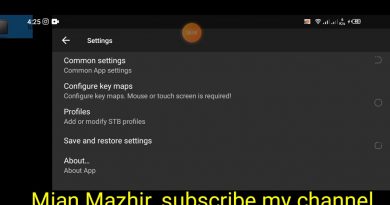(H3) Day8 – Networking Basics 4 – Devices- HUB, Repeater, Switch, Router, Modem, CMD-Ping, Tracert
20240308 122433
Networking Device
HUB
Repeater
Switch
Router
Modem
HUB
•It is not an Intelligent Device
It does not understand MAC address and IP address
•User for LAN communication
•suitable for Small networks
•OSI – Layer 1 Device (Physical Layer)
•It Broadcasts the packet to every device in network
A → B, A Send packet to B
A to Hub , Hub to B,C,D,E,F
B accepts packet, CDEF drop packet
•No of collisions occurs
•packet data loss
Repeater
Repeater repeat signal again , so signal can send to long distance
-Hub act like repeater
Ex. Repeater – Wifi extender
Switch
•It is an Intelligent Device
Understand MAC Address , learn MAC Address of Connected Devices
•It Maintain MAC Address Table (Hardware Address)
•Use for LAN Communication
•OSI – Layer 2 device (DataLink Layer)
•Small and Large networks
•Large number of devices can connect
Switch initially broadcast (send to every device) packets like HUB,
Switch verify MAC Address Table , against for Destination MAC address mapped PortNo, if it finds Packet sent to that port, (means later unicast)
•No of collisions are less , so less packet data loss
•It Works with Flooding and Unicast
•Cut through switch, Store and forward switch
Function of a Switch
•MAC Address Learning
•Forwarding
——————————-
•L3 Switch – do function as switch and router, not for WAN
•Used at inter-vlan routing, vtp
•Internetwork communication
Router
•It is an Intelligent Device
•It Works with Logical Addressing (i.e. IP, IPX, Apple Talk)
•Internetworking Device
•Connect two or more networks
•Use for LAN and WAN communication
•OSI – Layer 3 device (Network Layer)
•Route – path
•Router show best path to reach destination
•Routers use routing tables to know how reach destination
•Routers uses routing tables to get to know how to reach destination
•Routing Tables created by manually called Static routing
•Routing tables created by automatically by using routing protocols called Dynamic routing
•Dynamic Routing Protocols: IGP –RIPv2, EIGRP, OSPF, EGP –BGP, IS-IS
Modem:
•Modulator and Demodulator
•digital signal – Modem – analog signal
•Modem make you connects to ISP,
using Telephone, Fiber optical
•Modem connects to Internet
•Some WiFi routers / Router built in Modems
—
Ping: tells you’re device able to communicate to the destination device
Used to test connectivity between the devices
From PC-A , Ping to PC-B
At PC-A: cmd: ping 10.0.0.2
Reply from 10.0.0.2,……
Means PC-A to PC-B, PC-B to PC-A connectivity is there
Ping uses ICMP protocol, Ping Send ECHO Request – receive ECHO Response
C:UsersUser1)ping www.google.com
Pinging www.google.com [142.250.183.228] with 32 bytes of data:
Reply from 142.250.183.228: bytes=32 time=16ms TTL=119
Reply from 142.250.183.228: bytes=32 time=16ms TTL=119
Reply from 142.250.183.228: bytes=32 time=16ms TTL=119
Reply from 142.250.183.228: bytes=32 time=17ms TTL=119
Ping statistics for 142.250.183.228:
Packets: Sent = 4, Received = 4, Lost = 0 (0% loss),
Approximate round trip times in milli-seconds:
Minimum = 16ms, Maximum = 17ms, Average = 16ms
Tracert: tells how you reach destination, path
C:UsersUser1)tracert www.google.com
Tracing route to www.google.com [142.250.183.228]
over a maximum of 30 hops:
1 12 ms 38 ms 13 ms gateway.savantis.com [172.16.192.1]
2 8 ms 15 ms 25 ms 183.82.96.1.actcorp.in [183.82.96.1]
3 31 ms 6 ms * broadband.actcorp.in [183.83.249.10]
4 16 ms 16 ms 16 ms broadband.actcorp.in [183.82.14.78]
5 42 ms 23 ms 16 ms 72.14.243.242
6 24 ms 37 ms 29 ms 72.14.232.71
7 18 ms 20 ms 17 ms 209.85.247.251
8 23 ms 17 ms 18 ms maa05s23-in-f4.1e100.net [142.250.183.228]
Trace complete.
—————————————–
Ping Dip
Replay from Dip – good
Destination host unreachable – destination device down, wrong ip , disconnected
Request timed out – destination device down, wrong ip , disconnected, firewall block, path not available
C:UsersUser1)ping 172.16.192.1
Pinging 172.16.192.1 with 32 bytes of data:
Reply from 172.16.192.1: bytes=32 time=9ms TTL=64
Reply from 172.16.192.1: bytes=32 time=3ms TTL=64
Reply from 172.16.192.1: bytes=32 time=6ms TTL=64
Reply from 172.16.192.1: bytes=32 time=14ms TTL=64
C:UsersUser1)ping 172.16.192.100
Pinging 172.16.192.100 with 32 bytes of data:
Reply from 172.16.194.59: Destination host unreachable.
Reply from 172.16.194.59: Destination host unreachable.
Reply from 172.16.194.59: Destination host unreachable.
Reply from 172.16.194.59: Destination host unreachable.
C:UsersUser1)ping 172.16.19.1
Pinging 172.16.19.1 with 32 bytes of data:
Request timed out.
Request timed out.
Request timed out.
Request timed out.
mac address



